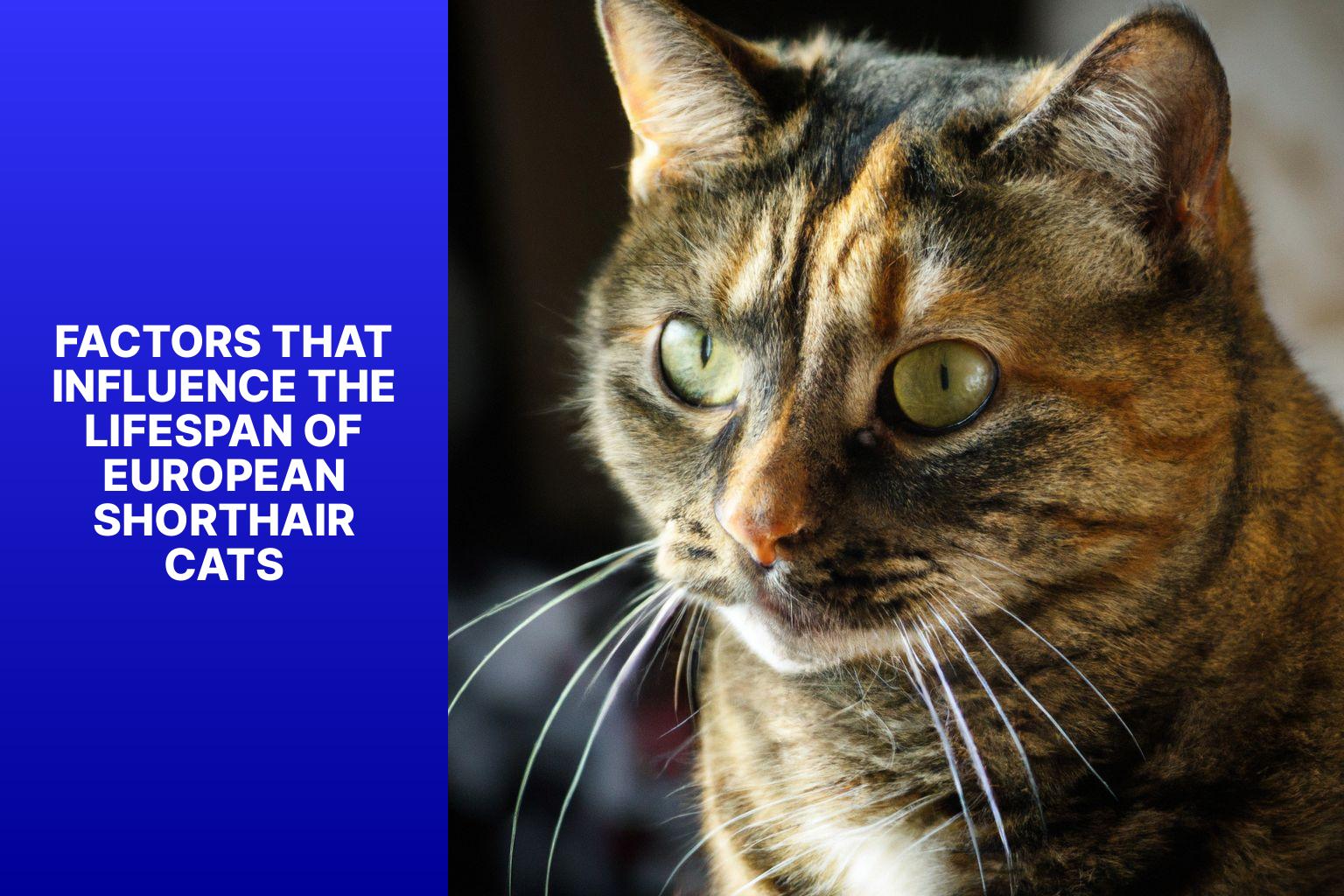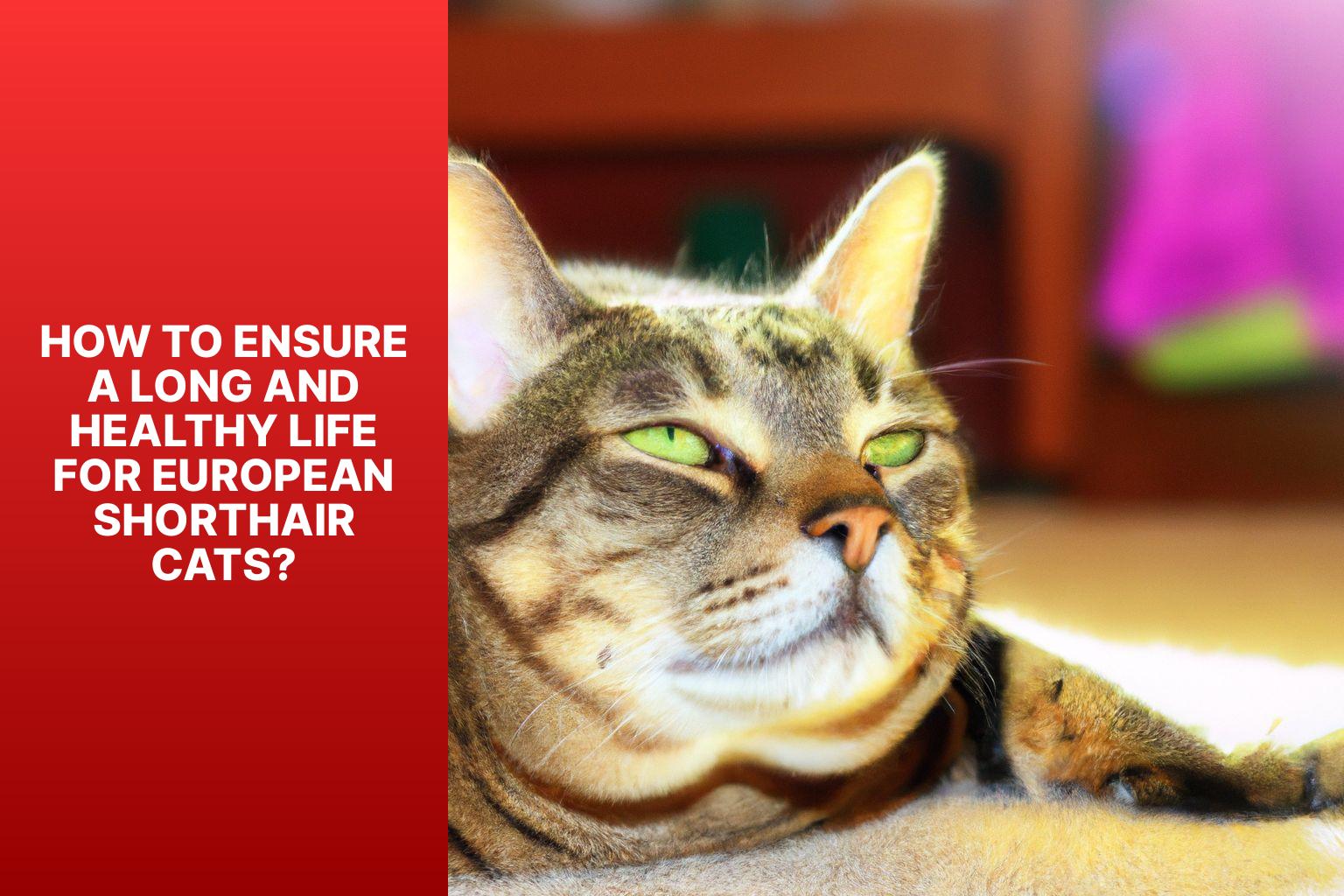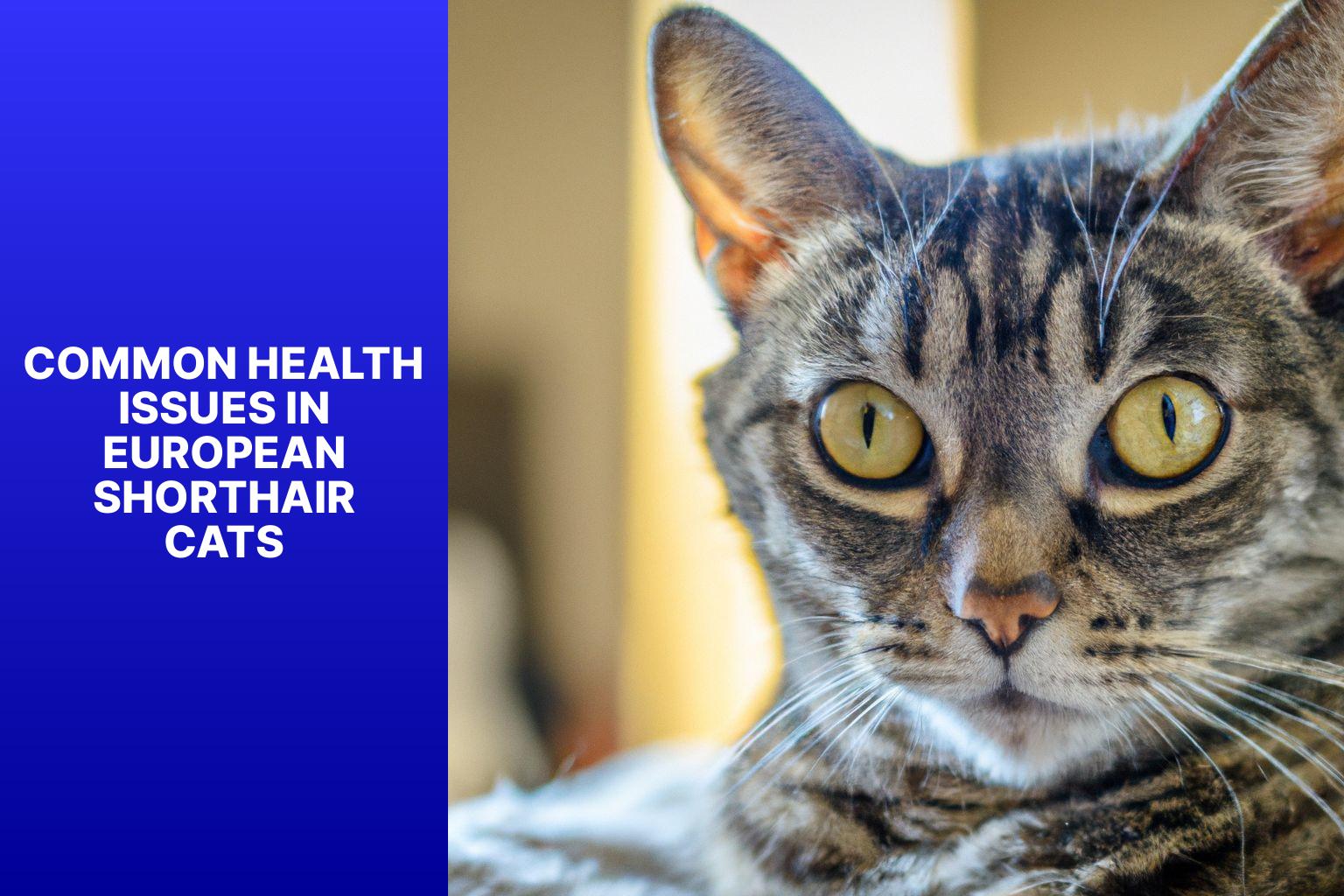European Shorthair cats are beloved pets known for their charming personality and adaptability. If you are considering adding one to your family, you may be wondering about their average lifespan and how to ensure they live a long and healthy life. Here is some information to help you understand the lifespan of European Shorthair cats and how to enhance their longevity.
Determining the exact lifespan of European Shorthair cats can be challenging as it can vary depending on various factors. On average, European Shorthair cats have a lifespan of around 12 to 16 years. With proper care and a healthy lifestyle, they can even live beyond these years.
Several factors can influence the lifespan of European Shorthair cats. These factors include:
Genetics and breeding play a significant role in a cat’s lifespan. European Shorthair cats come from a diverse genetic pool, which can contribute to their overall health and longevity.
Proper nutrition is essential for maintaining a cat’s overall health and extending their lifespan. Feeding a balanced and nutritious diet that meets their specific dietary needs is crucial.
Regular exercise and physical activity help promote good cardiovascular health, muscle tone, and weight management. Engaging in play and providing opportunities for stimulation is essential for European Shorthair cats.
Regular veterinary check-ups, vaccinations, and preventive care are vital for ensuring the well-being of European Shorthair cats. Prompt veterinary attention for any health issues is crucial for maintaining their lifespan.
Ensuring a long and healthy life for your European Shorthair cat involves providing the right care and creating a conducive environment that promotes their well-being. Here are some tips to help you enhance their lifespan:
Feed your European Shorthair cat a well-balanced and species-appropriate diet that meets their nutritional needs. Consult with a veterinarian to determine the best diet for your cat’s specific requirements.
Engage your cat in regular physical exercise through play and interactive toys. This helps to keep them active, maintain a healthy weight, and prevent obesity-related health issues.
Schedule regular veterinary check-ups to monitor your cat’s health, administer necessary vaccinations, and detect any potential health issues early. Follow your veterinarian’s recommendations for preventive care, such as flea and tick control and dental hygiene.
Provide an enriched environment for your European Shorthair cat with stimulating toys, scratching posts, and climbing structures. This helps to prevent boredom and increase mental stimulation, promoting their overall well-being.
While European Shorthair cats are generally healthy, they may be prone to certain health issues that can impact their lifespan. Some common health issues in European Shorthair cats include:
Periodontal diseases and dental issues can affect the overall health of European Shorthair cats. Regular dental care, including professional cleanings and brushing, is essential to maintain oral health.
European Shorthair cats can be prone to obesity, which can lead to various health complications. Regular exercise and portion-controlled feeding can help prevent obesity and maintain a healthy weight.
Urinary tract infections can occur in European Shorthair cats. Providing fresh water, a balanced diet, and maintaining proper hygiene can help prevent these infections.
Hypertrophic cardiomyopathy is a common heart condition in cats, including European Shorthair cats. Regular veterinary check-ups and a heart-healthy lifestyle can help manage this condition.
In addition to the above measures, there are some additional tips to enhance the lifespan of European Shorthair cats:
– Ensure they have a safe and secure environment.
– Minimize exposure to potential hazards or toxins.
– Provide mental stimulation through interactive play and puzzles.
– Maintain a stress-free and harmonious living environment.
By following these guidelines and providing appropriate care, you can help ensure a long and healthy life for your European Shorthair cat, increasing the chances of enjoying their companionship for many years to come.
Key takeaway:
- European Shorthair cats have an average lifespan: European Shorthair cats generally have an average lifespan that can range between 13 to 15 years.
- Factors influencing the lifespan of European Shorthair cats: Genetics and breed, diet and nutrition, exercise and physical activity, and veterinary care and health management play vital roles in determining the lifespan of European Shorthair cats.
- Enhancing the lifespan of European Shorthair cats: Providing a balanced and nutritious diet, regular physical exercise, veterinary check-ups and preventive care, and environmental enrichment can help ensure a long and healthy life for European Shorthair cats.
What is the Average Lifespan of European Shorthair Cats?
The average lifespan of European shorthair cats is 12 to 16 years. Factors like genetics, diet, exercise, and care can affect their lifespan.
To help your cat live a long and healthy life, provide a balanced diet, exercise regularly, and have regular check-ups.
Create a safe and stimulating environment with scratching posts, toys, and comfortable resting areas.
Keep their coat and skin healthy with regular grooming.
Spend quality time playing and providing mental stimulation.
Remember, each cat’s lifespan can vary. By providing proper care and meeting their specific needs, you can increase their chances of a long life.
Factors That Influence the Lifespan of European Shorthair Cats
Photo Credits: Www.Catcornerblog.Com by Dennis Baker
The lifespan of European Shorthair cats is influenced by various factors that we will dive into. From genetics and breed to diet and nutrition, exercise and physical activity, and veterinary care and health management, each aspect plays a crucial role in determining how long these delightful felines may live. Let’s explore the key influencers that shape the lifespan of European Shorthair cats and provide you with valuable insights to ensure they lead long and healthy lives.
Genetics and Breed
Genetics and breed play a significant role in determining the lifespan of European Shorthair cats. Each breed has its own life expectancy and is susceptible to specific genetic health issues.
| Breed | Average Lifespan | Genetic Health Issues |
| European Shorthair | 12-16 years | Hypertrophic Cardiomyopathy, Polycystic Kidney Disease |
| Maine Coon | 10-15 years | Hip Dysplasia, Hypertrophic Cardiomyopathy |
| Persian | 12-15 years | Polycystic Kidney Disease, Brachycephalic Airway Syndrome |
The European Shorthair breed has an average lifespan of 12-16 years. While they are generally healthy, they are prone to certain genetic health issues such as Hypertrophic Cardiomyopathy (a heart condition) and Polycystic Kidney Disease. Regular veterinary check-ups and genetic testing can help identify potential health issues early on, allowing for proper management and treatment.
Understanding the genetics and breed characteristics of European Shorthair cats is crucial for owners to make informed decisions and provide the necessary care for their cats’ well-being. Being aware of potential genetic health issues enables owners to be proactive in promoting the longevity and overall health of their beloved feline companions.
Diet and Nutrition
Proper diet and nutrition play a crucial role in maintaining the health and lifespan of European Shorthair cats. These cats require a balanced diet consisting of protein, carbohydrates, and fats for energy. High-quality meat or fish should be the main component of their diet to ensure muscle development and a strong immune system.
While cats only need a small amount of carbohydrates, including whole grains and vegetables in their diet can provide fiber and energy. The inclusion of omega-3 fatty acids, found in fish oil or flaxseed oil, can promote a shiny coat and support brain function. Being obligate carnivores, European Shorthair cats obtain essential nutrients from animal tissues, so a meat-based diet is necessary.
Controlling portion sizes is important to prevent obesity in these cats, so it is advised to follow feeding guidelines based on their age, weight, and activity level. Cat owners should ensure that freshwater is always available for their pets to keep them well-hydrated.
In order to enhance the health and longevity of European Shorthair cats, providing a balanced and nutritious diet is paramount. Regular veterinary check-ups, preventive care, environmental enrichment, and regular physical exercise are also crucial for their overall well-being and for ensuring a long and healthy life for these cats.
Exercise and Physical Activity
Exercise and physical activity play a crucial role in the well-being and longevity of European Shorthair cats. It is important to consider the following points:
1. Regular exercise is necessary for these cats to maintain a healthy weight and promote muscle tone. Aim for 20-30 minutes of playtime or interactive exercise each day.
2. Interactive play sessions with toys, such as chasing a feather wand or batting at a ball, stimulate their natural hunting instincts and provide mental and physical stimulation.
3. Environmental enrichment is essential. Provide a stimulating environment with scratching posts, climbing trees, and interactive toys to encourage physical activity and prevent obesity.
4. It is generally safer to provide exercise opportunities indoors to protect European Shorthair cats from potential dangers like traffic, predators, and contagious diseases. Supervised outdoor time may be enjoyed by some cats.
5. Creating an obstacle course with tunnels, hurdles, and ramps can be a fun and engaging way to promote exercise and agility in European Shorthair cats.
6. Cats are highly social animals. Engaging in interactive play or providing companionship with other pets can motivate them to be more active.
7. Tailor the activities and intensity of exercise to suit the age and physical abilities of your cat.
Remember, regular exercise and physical activity are essential for European Shorthair cats to maintain a healthy weight, prevent boredom, and enhance their overall well-being.
Veterinary Care and Health Management
When it comes to veterinary care for European Shorthair cats, it is important to prioritize Veterinary Care and Health Management. Consider the following:
-Regular veterinary check-ups: Schedule regular check-ups to monitor the cat’s health and catch potential issues early.
–Vaccinations: Keep your European Shorthair cat up to date with vaccinations to prevent diseases and maintain their immune system.
–Parasite control: Implement a regular program for flea and tick control, as well as deworming, to protect your cat from harmful parasites.
–Dental care: Regular teeth brushing and dental cleanings can prevent dental problems like gum disease and tooth loss.
–Weight management: Maintaining a healthy weight is crucial for your cat’s overall well-being. Obesity can lead to health problems such as joint issues and diabetes.
–Exercise: Providing opportunities for physical activity and mental stimulation is important for your European Shorthair‘s health and well-being.
–Spaying/neutering: Consider spaying or neutering your European Shorthair to contribute to their overall health, reduce the risk of certain diseases, and prevent unwanted pregnancies.
–Stress management: Cats are sensitive to stress, so creating a calm and enriched environment contributes to their health and well-being.
By prioritizing Veterinary Care and Health Management and following these measures, you can ensure the optimal health and longevity of your European Shorthair cat.
How to Ensure a Long and Healthy Life for European Shorthair Cats?
Photo Credits: Www.Catcornerblog.Com by Robert Jones
Looking to ensure a long and healthy life for your European Shorthair cat? Let’s explore some key strategies that can make a real difference. Discover the secrets of providing a balanced and nutritious diet, engaging them in regular physical exercise, scheduling regular veterinary check-ups, and creating an enriching environment for their wellbeing. With these valuable insights, you’ll be equipped to give your European Shorthair the best chance at a vibrant and thriving life. So, let’s dive in and uncover the key ingredients to their longevity and happiness!
Balanced and Nutritious Diet
A balanced and nutritious diet is crucial for the long and healthy life of European Shorthair cats.
It is important to ensure proper portion control and follow feeding guidelines to prevent obesity and maintain a healthy weight.
To support muscle development and overall health, it is recommended to provide a substantial amount of protein from sources like chicken, fish, or turkey.
In addition, it is essential to include essential nutrients, vitamins, and minerals in their diet to promote healthy organ function, support their immune system, and ensure optimal growth and development.
For energy and digestive health, it is advisable to choose cat food that contains easily digestible carbohydrates such as rice or sweet potato.
Incorporating healthy fats like omega-3 and omega-6 fatty acids in their diet can improve their skin and coat health and serve as a good energy source.
It is advisable to avoid cat food that contains fillers, artificial colors, flavors, and preservatives, as these can have a negative impact on their overall health.
It is crucial to always provide fresh and clean water for hydration and to support their overall health and well-being.
By providing a balanced and nutritious diet, you can ensure that your European Shorthair cat enjoys a long and healthy life.
Regular Physical Exercise
Regular physical exercise is of utmost importance for the well-being and longevity of European Shorthair cats. Incorporating regular exercise into their daily routine is essential in maintaining a healthy weight, improving cardiovascular health, strengthening muscles, and enhancing agility and coordination.
Owners can provide exercise opportunities through the use of interactive toys, scratching posts, and climbing structures, and they should set aside 20-30 minutes each day for dedicated play and exercise sessions.
It is crucial to take into account the individual needs and limitations of each cat, such as age, health, and mobility. Consultation with a veterinarian can provide tailored guidance in this regard.
By incorporating regular exercise, the overall health of European Shorthair cats is promoted, leading to increased lifespan and ensuring that they live long and healthy lives.
Veterinary Check-ups and Preventive Care
Veterinary check-ups and preventive care are essential for the long and healthy life of European Shorthair cats. Regular visits to the veterinarian can detect potential health issues early and prevent them from worsening. Here are some important aspects of veterinary check-ups and preventive care for European Shorthair cats:
1. Annual check-ups: Cats should have a comprehensive physical examination by a veterinarian every year. This allows the vet to assess the cat’s overall health and detect signs of illness or disease.
2. Vaccinations: Vaccinations protect cats against common feline diseases. Your veterinarian will recommend the appropriate vaccines for your European Shorthair cat.
3. Parasite control: Regular deworming and flea/tick control are essential to prevent infestations and the spread of diseases. Your veterinarian can advise you on suitable preventive products.
4. Dental care: Good oral hygiene is important for your cat’s health. Dental check-ups, cleanings, and home dental care routines can prevent dental problems.
5. Spaying/neutering: Unless you plan to breed your European Shorthair cat, spaying or neutering is recommended. This prevents unwanted litters and reduces the risk of certain health conditions.
6. Monitoring weight and diet: Your veterinarian can help monitor your cat’s weight and provide guidance on appropriate diets to prevent obesity and related health issues.
By prioritizing regular veterinary check-ups and preventive care, you can ensure that your European Shorthair cat remains healthy and enjoys a long, happy life.
Environmental Enrichment
Environmental enrichment is crucial for enhancing the well-being and quality of life for European Shorthair cats. Providing a stimulating environment is key to keeping cats mentally and physically active.
There are several ways to engage and stimulate cats. Interactive toys and puzzles, such as puzzle feeders, treat-dispensing toys, and toys that mimic hunting and chasing, can provide hours of entertainment. Additionally, cat trees and scratching posts offer vertical spaces for climbing, scratching, and surveying their environment, satisfying their natural instincts and promoting exercise.
Cozy hideouts and quiet spaces, such as cat beds or enclosed cat condos, play a vital role in giving cats a sense of security and a place to rest. Window perches near a window also allow cats to observe the outside world, providing them with a much-needed mental stimulation.
Regular play sessions and interaction with toys or laser pointers are important to keep cats physically active and mentally engaged. It is also beneficial to rotate toys and introduce new forms of stimulation to prevent boredom and maintain their interest in the environment.
If it is safe and appropriate, providing supervised access to outdoor spaces can expose cats to fresh air and natural elements, further enriching their lives.
By implementing these strategies, you can ensure that your European Shorthair cat has a fulfilling and enriched life, promoting their well-being and happiness.
Common Health Issues in European Shorthair Cats
Photo Credits: Www.Catcornerblog.Com by Keith Miller
European Shorthair cats are known for their robust nature, but they can also suffer from various health issues. In this section, we will shed light on the common health concerns faced by these magnificent felines. From dental problems to obesity, urinary tract infections, and even hypertrophic cardiomyopathy, we will explore the challenges that European Shorthair cats may encounter. So, buckle up and get ready to delve into the world of feline health as we uncover the potential ailments that can affect these adorable companions!
Dental Problems
Dental problems can occur in European Shorthair cats, including dental plaque and tartar buildup if not regularly removed. If left untreated, dental plaque can lead to gingivitis, which is characterized by red, swollen gums and bad breath. Periodontal disease is also common in European Shorthair cats, which can result in tooth loss, pain, and infection. Cats may develop oral ulcers from various causes such as trauma, viral infections, or autoimmune conditions, which can affect their eating and grooming habits. In particular, European Shorthair cats are predisposed to stomatitis, a severe inflammation of the oral cavity, which can cause oral lesions, difficulty eating, and weight loss.
Let me share a true story about a European Shorthair cat named Max who experienced severe dental problems. Max exhibited bad breath and had difficulty eating. Upon examination by the vet, it was discovered that he had extensive dental plaque, gingivitis, and loose teeth. As a result, Max underwent anesthesia for a dental cleaning procedure to remove the plaque and tartar. Due to severe periodontal disease, a few teeth needed to be extracted. Following the procedure, Max’s oral health noticeably improved, and his appetite returned. Regular dental care, including brushing and the use of dental treats, helped prevent further dental issues for Max.
Obesity
Obesity is a significant health issue in European Shorthair cats. To ensure their well-being and longevity, it is important to address and manage this condition.
1. Overfeeding: Obesity often results from overfeeding. Owners should avoid excessive calorie intake and provide an appropriate portion size based on the cat’s age, weight, and activity levels.
2. Nutritional Balance: A balanced diet is crucial for preventing obesity. Feeding high-quality cat food that meets nutritional requirements without excessive fat content is essential.
3. Regular Exercise: Physical activity plays a vital role in maintaining a healthy weight. Encouraging playtime and providing exercise opportunities can help cats burn calories and prevent weight gain.
4. Portion Control: Measuring food and dividing it into smaller, frequent meals can prevent overeating and keep weight in check.
5. Veterinary Monitoring: Regular check-ups with a veterinarian can help monitor a cat’s weight and overall health. They can provide guidance on appropriate feeding and weight management strategies.
6. Environmental Enrichment: Providing stimulating and engaging environments can prevent obesity. Interactive toys, scratching posts, and vertical spaces encourage physical activity and mental stimulation.
Prompt action is necessary to address obesity in European Shorthair cats. By implementing proper nutrition, regular exercise, and veterinary care, owners can help their cats maintain a healthy weight and improve their overall quality of life.
Urinary Tract Infections
Urinary Tract Infections (UTIs) are a common occurrence in European Shorthair cats. When bacteria enter their urinary system, it can lead to inflammation and discomfort. Recognizing the signs and symptoms of UTIs is crucial in order to promptly seek the necessary veterinary care. To provide more insight into UTIs in European Shorthair cats, here are some important facts to consider:
1. Both male and female cats can be affected by UTIs, but they are more prevalent in males due to their longer and narrower urethra.
2. Symptoms of UTIs in cats may include frequent urination, straining to urinate, blood in the urine, and urinating outside of the litter box.
3. Several factors can contribute to the development of UTIs, such as poor hygiene, urinary tract abnormalities, bladder stones, and a weakened immune system.
4. Veterinary treatment for UTIs typically involves the prescription of antibiotics. It is crucial to complete the entire course of medication to fully eliminate the infection.
5. Taking preventive measures can help reduce the risk of UTIs in European Shorthair cats. Providing them with fresh and clean water at all times, maintaining proper litter box hygiene, and feeding them a balanced and nutritious diet are all beneficial.
6. Regular veterinary check-ups and preventive care play a significant role in identifying and addressing any underlying issues that may increase the likelihood of UTIs.
7. If you suspect that your European Shorthair cat has a UTI, it is essential to seek veterinary attention as soon as possible to prevent complications and ensure their well-being.
By being aware of the signs, implementing preventive measures, and promptly seeking veterinary care, you can contribute to the overall health and longevity of your European Shorthair cat regarding UTIs.
Hypertrophic Cardiomyopathy
Hypertrophic cardiomyopathy is a common health issue in European Shorthair cats. This condition thickens the heart muscle, leading to problems with heart function and overall health.
Symptoms of hypertrophic cardiomyopathy may include difficulty breathing, coughing, lethargy, and decreased appetite. If untreated, this condition can cause heart failure or sudden death.
To diagnose hypertrophic cardiomyopathy, a veterinarian will perform a physical examination, listen to the cat’s heart, and may recommend further tests such as an echocardiogram or electrocardiogram.
Treatment options for hypertrophic cardiomyopathy in cats may include medication to manage symptoms, like beta-blockers or calcium channel blockers. In some cases, surgical intervention may be necessary.
Prevention and management of hypertrophic cardiomyopathy can be done through regular veterinary check-ups to monitor heart health, maintaining a balanced diet to prevent obesity, and providing environmental enrichment to reduce stress.
It is important to be aware of the signs and symptoms of hypertrophic cardiomyopathy in European Shorthair cats. Early detection and intervention can greatly improve their quality of life and increase their lifespan. Regular veterinary care and a healthy lifestyle can help manage this condition and enhance the overall well-being of these cats.
Tips for Enhancing the Lifespan of European Shorthair Cats
To enhance the lifespan of European Shorthair Cats, follow these tips:
- Feed your cat high-quality, balanced cat food to provide necessary nutrients. Avoid overfeeding to prevent obesity.
- Schedule annual check-ups with a veterinarian for regular health monitoring. Vaccinations and preventive treatments are essential.
- Engage your cat in play activities and provide toys for physical and mental stimulation. This maintains overall well-being.
- Regularly brush your cat’s teeth or provide dental treats to prevent periodontal disease, which can impact longevity.
- Create a secure and enriching living space for your cat. Keep them indoors to protect from accidents, predators, and diseases.
- Spay or neuter your cat to prevent certain health issues and reduce the risk of cancers.
- Monitor your cat’s weight and maintain a healthy body condition. Obesity can lead to health problems.
- Minimize stressors in your cat’s environment. Provide hiding spots, a comfortable sleeping area, and avoid sudden changes.
By following these tips, you can enhance the lifespan and overall well-being of your European Shorthair Cat. Remember, each cat is unique, so tailor their care to their individual needs.
Some Facts About How Long European Shorthair Cats Live:
- ✅ The average lifespan of European Shorthair cats is 14 years.
- ✅ Indoor European Shorthair cats tend to live longer than those who roam outside.
- ✅ European Shorthair cats have been known to live up to 20 years.
- ✅ Proper care, nutrition, and regular vet check-ups can help increase the lifespan of European Shorthair cats.
- ✅ European Shorthair cats are generally considered to have a relatively long life compared to other cat breeds.








